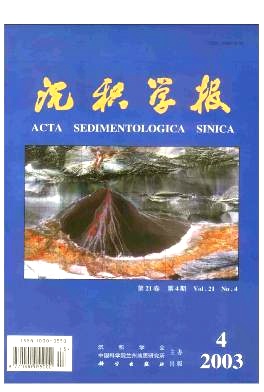|
[1]
|
MacDonald G I F. The deep structure of continents[J]. Review Geophysics,1963,1:587~665 |
|
[2]
|
傅成仪. 地球十讲[M].北京:科学出版社,1976. 11~60[Fu Chengyi. Ten Lectures on Earth[M]. Beijing: Science Press,1976. 11~60] |
|
[3]
|
Roy R F,Blackwell D D,Birch F. Heat generation of plutonic rocks and continental heat flow provinces[J]. Earth Planetary Science Letter,1968,5:1~12 |
|
[4]
|
周惠兰. 地球内部物理[M]. 北京:地震出版社,1990. 167~213[Zhou Huilan. The Earth Interior Physics[M]. Beijing: Seismology Press,1990. 167~213] |
|
[5]
|
Kremenetsky A,Milanovsky S Y,Ovchinnikov L N. A heat generation model for continental crust based on deep drilling in the Baltic shield[J]. Tectonophysics,1989,159: 231~246 |
|
[6]
|
Morgan P,Sass J H. Thermal regime of the continental lithosphere[J]. J.Geodynamics,1984,1:143~166 |
|
[7]
|
Liu Guangding. Geophysical and geological exploration and hydrocarbon prospects of the East China Sea[J].China Earth Sciences,1989,1(1):43~58 |
|
[8]
|
李乃胜. 冲绳海槽地质构造属性[J]. 海洋与湖沼,1990,21(6): 536~543[Li Naisheng. The tectonic geology of Okinawa Trough[J]. Oceanologia et Limnologia Sinica,1990,21(6): 536~543] |
|
[9]
|
李凤业,史玉兰,何丽娟,等. 冲绳海槽晚更新世以来沉积速率的变化与沉积环境的关系[J]. 海洋与湖沼,1999,30(5): 540~545[Li Fengye,She Yulan,He Lijuan,et al. The relationship between sedimentation rate and environment of Okinawa Trough since Late Pleistocene[J]. Oceanologia et Limnologia Sinica,1999,30(5): 540~545] |
|
[10]
|
栾锡武. 我国东海及其邻近海域海底热流与数值模拟[J]. 海洋与湖沼,1997,28(1): 44~48[Luan Xiwu. Study of heatflow distribution of Ryukyu Ta-B-A system and thermo dynamic modeling of Okinawa Trough[J]. Oceanologia et Limnologia Sinica,1997,28(1): 44~48] |
|
[11]
|
栾锡武,高德章,秦蕴珊,等. 我国东海陆架区新生代地层岩石热导率研究[J]. 海洋与湖沼,2002,33(2):87~94[Luan Xiwu,Gao Dezhang,Qin Yunshan,Zhao Jinhai. Thermal conductivity of the Cenozoic Layer of East China Sea Shelf[J]. Oceanologia et Limnologia Sinica,2002,33(2):87~94] |
|
[12]
|
赵平,汪集日易,汪缉安. 中国东南地区岩石生热率研究[J]. 岩石学报,1995,11(3):292~305[Zhao Ping,Wang Jiyang,Wang Jian. Characteristics of heat production distribution in SE China[J]. Acta Petrologica Sinica,1995,11(3):292:305] |
|
[13]
|
赵平,汪集日易,汪缉安. 热流和岩石生热率关系的研究[J]. 地质科学,1996,31(3):297~307[Zhao Ping,Wang Jiyang,Wang Jian. Heat flow and heat production relation[J]. Scientia Geologica Sinica,1996,31(3):297~307] |
|
[14]
|
Rybach L, Buntebarth G. Relationships between the petrophysical properties density,seismic velocity,heat generation, and mineralogical constitution[J]. Earth and Planetary Science Letter,1982,57:367~376 |
|
[15]
|
赵一阳,焉明才. 中国浅海沉积物地球化学[M]. 北京:科学出版社,1994. 15-190[Zhao Yiyang,Yan Mingcai. Geochemistry of China offshore sediment[M]. Beijing: Science Press,1994. 15~190] |
|
[16]
|
李培英,王永吉,刘振夏. 冲绳海槽年代地层与沉积速率[J]. 中国科学(D),1999,29(1):50~55[Li Peiying,Wang Yongji,Liu Zhen-xia. Chronostratigraphy and sedimentation rate of Okinawa Trough[J]. Sciencesin China( series D),1999,29(1):50~55] |
|
[17]
|
Furukawa Y, Uyeda S. Thermal state under the Tohoko Arc with consideration of crustal heat generation[J]. Tectonophysics,1989,164:175~187 |
|
[18]
|
Hayes D E. A Geophysical atlas of the East and Southeast Asia Sea[M].Springer,1978 |
|
[19]
|
俞印生. 东海陆架盆地新生代地层层序及其沉积特征[A]. 见:刘光鼎编著. 中国海区及邻域地质地球物理特征[C]. 北京:科学出版社, 1992. 302~307[Yu Yinsheng. Cenozoic sequence of the East China Sea Shelf Basin and the sedimentary features[A]. In: Liu Guangding ed. Geologic-geophysic features of China Seas and adjacent regions[C]. Beijing: Science Press,1992. 302~307] |
|
[20]
|
徐尚武. 东海地震勘探[A]. 见:刘光鼎编著. 中国海区及邻域地质地球物理特征[C]. 北京:科学出版社,1992. 124~130[Xu Shangwu. Seismic Prospecting in the East China Sea[A]. In: Liu Guangding ed. Geologic-geophysic features of China Seas and adjacent regions[C]. Beijing: Science Press,1992. 124~130] |
|
[21]
|
许薇龄,焦荣昌,周德雨,等. 东海地区深部构造的地球物理研究与盆地演化[A]. 见:刘宝王君,李思田主编. 第30届国际地质大会论文集,8[C]. 北京:地质出版社,1997. 245~254[Xu Weiling,Jiao Rongchang,Zhou Deyu,et al. Deep tectonic and basin evolution of the East China Sea[A]. In: Liu Baojun,Li Sitian,eds. Proceedings of the 30th International Geological Symposium,8[C]. Beijing: Geological Publishing House,1997. 245~254] |
|
[22]
|
Rybach L, Buntebarth G. The variation of heat generation density and seismic velocity with rock type in the continental lithosphere[J]. Tectonophysics,1984,103:334~344 |
|
[23]
|
王良书,施央申. 油气盆地地热研究[M]. 南京:南京大学出版社,1989. 21~44[Wang Liangshu,Shi Yangshen. The geothermal study of oil and gas basin[M]. Nanjing: Nanjing University Press,1989. 21~44] |
|
[24]
|
栾锡武,赵一阳,秦蕴珊,等. 我国东海及其邻近海域天然气水合物可能的分布范围[J]. 沉积学报,2001,19(2):211~218[Luan Xiwu,Zhao Yiyang,Qin Yunshan, et al. The possible distribution of hydrate gas in the Area of East China Sea and its vicinity[J]. Acta Sedimentologica Sinica,2001,19(2):211~218] |






 DownLoad:
DownLoad: